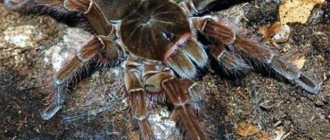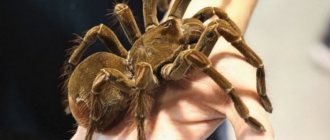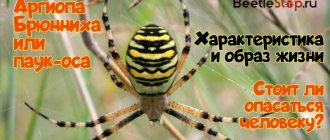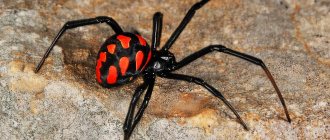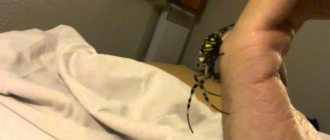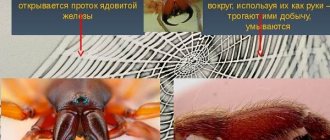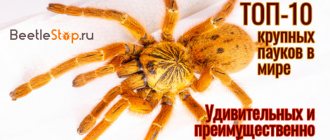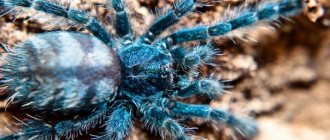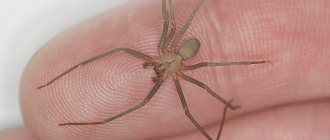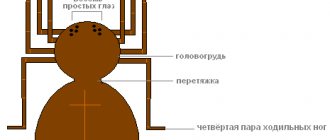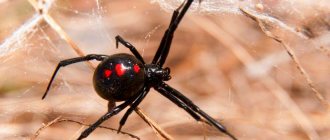The Argiope Brünnich spider was named after the scientist Morten Trane Brünnich. The species belongs to the orb weaver family. Also known as wasp spider, tiger spider, bee spider and zebra spider.
Widely distributed throughout almost the entire globe. Famous for its ability to weave finely patterned webs.
This species is capable of spreading over large areas, using rising air currents and webs for movement. Next, we will consider the appearance, habitat, lifestyle, feeding habits and reproduction of argiope.
Appearance
Due to its color, the spider with striped legs received several more names:
- yellow and black spider;
- zebra spider;
- tiger spider;
- wasp spider (bee);
- spider with a yellow butt.
Females from the genus Argiopus are strikingly different in size from their “narrowed” ones: they are five times longer than them. The body of the female reaches 30 mm, and together with the legs, the spider is 2 times longer.
Argiope has pale yellow stripes on its paws. Zebra spiders move on eight legs. The last two legs have claws and bristles - they use them to weave their webs.
All arachnids lack a spine. Wasp spiders are lobed and consist of two parts. The head of arthropods is fused with the chest. The cephalothorax, covered with a hard shell, is connected by a thin waist to the abdomen. These segments form the body of the tiger spider. Argiope has eight eyes, two jaws and a pair of antennae for seeing, biting and feeling.
Males are not only tiny (up to 5 mm), but also inconspicuous - brown or gray in color. On the mustache of males there are bulbs - organs that perform reproductive functions. Argiope spiders of different sexes live separately, each on their own, until the “mating season” begins.
Habitat
The spider with yellow and black stripes is predisposed to mild, warm climates and does not tolerate high humidity and cold. This explains the choice of its habitat:
- Africa;
- Asia;
- Indonesia;
- Korea;
- China;
- European countries (central, southern);
- South and North (up to Canada) America.
In Russia and the CIS countries, Argiope Brünnich lives in warm regions. The yellow-bellied spider loves to soak up the sun. He feels comfortable on open lawns, forest clearings, and roadsides.
The animal hangs its trap nets close to the surface of the earth, at a height of 30-40 centimeters. To do this, he chooses neglected places where he will not be disturbed by either animals or people.
On a note. Wasp spiders live in groups: where there is one, there will definitely be another two to three dozen individuals nearby.
The black and yellow spider has the ability to move through the air over long distances. The lack of wings is compensated for by a self-woven long and strong web. Blown away by the wind, she can deliver her “weaver” to quite remote places. It is not surprising that heat-loving arthropods can also live in cold northern latitudes.
Habitat of the Agryope Brünnich spider
This type of spider prefers steppe and desert zones. Their habitat covers almost the entire Palearctic region. Agryope Brünnich can be found in the following regions:
- Southern and Central Europe;
- North Africa;
- Asia Minor and Central Asia;
- Far East;
- Japanese islands.
In Russia, the wasp spider is found mainly in the southern part of the country, but every year representatives of this species are increasingly found in more northern regions. At the moment, you can encounter Agriopa in Russia in the following areas:
- Chelyabinskaya;
- Lipetskaya;
- Orlovskaya;
- Kaluzhskaya;
- Saratovskaya;
- Orenburgskaya;
- Samara;
- Moscow;
- Bryansk;
- Voronezh;
- Tambovskaya;
- Penza;
- Ulyanovskaya;
- Novgorodskaya;
- Nizhny Novgorod.
Lifestyle
The bee spider does not survive alone, and therefore joins the flock: this makes it easier to get food and reproduce. Matriarchy reigns in the Argiope family. The main “mistress of the house” - the spider - chooses the place of future housing, mobilizes other individuals to create net traps for hunting.
Each member of the flock is given no more than 60 minutes to create a web that is not only durable, wide-format (up to half a meter), but also attractively lacy. Even a small mosquito should not slip through it. Spiders cope.
The algorithm for catching and eating food is the same for all arthropods:
- To prevent the victim caught in the snare from tearing the web, the argiope inflicts a poisonous bite on it and injects its digestive enzymes into it.
- The paralyzed insect stops resisting.
- Enzymes dissolve the insides of prey, turning them into a liquid substance.
- Argiope Brünnich waits until the food is “infused” and becomes suitable for consumption, after which it sucks it out, leaving only the dry shell of the insect’s body in the web.
When the remains of prey accumulate in the nets of a striped animal, it leaves them and scatters its hunting gear in a new place in order to lull the vigilance of future potential victims.
Nutrition
Tenacious and attractive webs of poisonous Argiope spiders are rarely empty. They often come across:
- flies;
- dragonflies;
- grasshoppers;
- locusts;
- small insects.
Sometimes wasps or bees are accidentally captured, and the “hunter” himself can die from their poison. The situation is undesirable. Already, the life expectancy of a spider with orange stripes does not exceed a year.
To fill its belly, the spider tigress only needs one successful hunt per week. She is ready to wait for hours for a victim, and then quickly “pack” him into a web film, inject poison into him, paralyze him and empty him into a chitinous shell.
Reproduction
Theoretically, Brünnich's Argiopes can live up to one year. However, their lifespan is much shorter. Males die first, spiders a little later. Paradoxically, they die in the name of procreation, during the period of mating, laying and nursing eggs. The natural reproduction process of striped arthropods of this species occurs in stages:
- The tiger spider looks for a partner in advance, then settles on the edge of her web and waits for the start of molting - a signal for mating. He does not vibrate his paws, he freezes so that the female does not mistake him for prey.
- After sexual intercourse, the Argiope spider eats the male, which resembles the behavior of a black widow in a similar situation.
- Before becoming a protein supplement for its “betrothed,” the spider “clogs” the female, leaving no chance for possible competitors.
- After thirty days, the argiope Brünnich weaves a large cocoon (sometimes more than one), into which it lays up to four hundred eggs. Then he carefully wraps the “cradle” in a strong web and dies.
- Warm cocoons allow the spiders to overwinter in the eggs. In the spring they hatch and, caught by the wind, fly away in all four directions. The life chain of the Argiope genus is not interrupted.
On a note. During Indian summer, many flying white cobwebs appear in the air. Transparent, they appear “uninhabited”. However, if you look closely, you can see a miniature arthropod creature conceived in early summer. Let yourself fly to a new life!
Do Argiopes bite?
Any spider can bite, and a tiger spider is no exception. The bite of the Argiope Brünnich spider is not capable of causing serious harm to human health, but unpleasant consequences are possible. In terms of the body's reaction, it resembles a wasp sting. A spot and a small tumor forms around the wound.
You should beware of the bee spider, as it has quite strong jaws. They can inflict a deep wound into which a non-lethal, but still poison, will enter and cause dangerous symptoms. Allergy sufferers and children with an immature immune system are especially sensitive. Severe itching, burning, swelling, possibly nausea and dizziness are good reasons to consult a doctor. Most people experience mild pain that goes away within an hour or two.
The yellow butt spider will not bite unless it is in danger. Just don’t touch its web, admire the animal’s unique coloring from the side and leave it alone with its worries.
Danger to humans
As a rule, males and young individuals do not pose a danger to humans, since they cannot bite through the skin with their weak jaws, although isolated cases of attacks are known. Adult females pose a danger, especially in July-August. You can distinguish the female by its color. Males have red spots with white rims, while females have no edging. Sometimes in females the red spots change to yellow stripes. Females have long legs up to 30 mm and are significantly larger than males.
The attack happens very quickly. Karakurt attacks only in self-defense. Nature has endowed the spider with such a strong poison so that it can capture the burrows of small rodents, which do not come into conflict with it and immediately vacate their territory. A predator can attack when it first seems to be in danger, so it is better to avoid contact with it. The difficulty in detecting danger lies in the fact that karakurts do not weave their net in the classical way. The threads are arranged horizontally, the web does not have a characteristic pattern and is chaotic. Attacks occur most often at night and on vacation, when you can accidentally crush the karakurt or disturb the web.
A spider bite is not painless, but it does not cause much concern. The bite site is marked with a small red spot, which disappears after a few minutes. After the poison has taken effect, the bitten person begins to experience severe pain in the damaged area. Specific psychological and physiological reactions arise.
In the first minutes and hours after the bite, poisoning is characterized by the following symptoms:
- strong mental agitation;
- feeling of fear of death, panic;
- spasms and suffocation;
- severe pain in the abdomen, chest and lower back;
- feeling that the legs are being taken away;
- bluish complexion;
- shallow breathing, dizziness;
- sometimes cramps of the arms and legs, tremors, vomiting;
- increased heart rate, arrhythmia;
- retention of urination and defecation;
- increased protein content in urine.
Argiope Brünnich's web
The wasp spider is classified as a member of the orb weaver family. He is an expert in circular weaving, draws spiral patterns from cobwebs, attaches them to zigzag threads with many small cells.
The web is strong, capable of holding a captive about six centimeters in size. The tiger predator uses its ability to reflect ultraviolet rays for hunting.
Two thickened zigzags (stabilentum) in the middle, directed in different directions, have the greatest reflectivity. They are:
- lure small prey into nets;
- serve as a “road sign” on the path of larger animals, so that they do not inadvertently run into the web, damaging it;
- they confuse and scare off the natural enemies of Argiopus with the glare that the street spider creates by feverishly shaking its catching net.
Argiope Brünnich begins to weave a web at dusk. The intricate design and complexity of the design enhance the brilliance of the reflected ultraviolet light and the effectiveness of the natural traffic light trap.
On a note. The wasp spider works on his masterpiece for about an hour. Then it settles down in the center of the web, hanging head down. In this position, he can remain motionless, waiting for the victim, day and night.
Medium poisonous spiders
banana spider
Giant tree spider
goldweaver
Tarantula
Spider wasp (Argiope brunnich)
Females are larger (especially in late summer, before eggs are laid), and the thorax is brightly colored with yellow, black and white stripes, reminiscent of a wasp. Males are tiny and do not look like females. Weaving webs in high meadows. The network is characteristic, with an obvious zigzag pattern. As a rule, they feed on grasshoppers and other insects caught in the net.
How does a striped spider hunt?
Argiope Brünnich never attacks prey from hiding. She is in the center of events, in the most visible place - in the middle of the spider web. Ultraviolet rays reflected by the web make the stripes on the back, sides and legs of the tiger spider even brighter.
This openness does not prevent the spider from hunting. On the contrary, it only adds color to the overall picture. Most insects, when migrating, are drawn to the light, so they certainly “look at the light” into the glowing spider house, where a completely inhospitable owner is patiently waiting for it.
Having twisted the prey with spider threads, the striped predator plunges its jaws into it, injecting a paralyzing poison that turns the insect tissue into a liquefied substance. The tiger spider then sucks out all the juices from the victim, of which only a dry shell remains. The menu of the Argiope spider, in addition to crickets, mosquitoes, flies and other small creatures, also includes medium-sized flying beetles.
On a note. Argiope Brünnich "packs" its prey into a web bag with amazing speed. Hand luggage packers at airport terminals can envy such speed and quality. A few moments - and the gaping, immobilized victim humbly awaits his unenviable fate in the tenacious nets of a hunter with a yellow-black belly.
Enemies of the striped wasp spider
The varied colors of arthropods have their own meaning and purpose. For example, crosses have light white dots in the shape of a cross on their backs. This pattern scares away the spider's enemies.
Nature painted Argiope spiders with yellow and black stripes, making them look like wasps and hornets, to protect this genus of arthropods from birds. Feathered predators cannot stand them.
The Argiopes live in peace and harmony with their relatives. Striped spiders settle away from garden plots, vine terraces and flower plantings. They cannot tolerate the sweetish aromas of grapes and fragrant flowers.
The sticky web, as well as the collective way of existence, reliably protects them from ants, centipedes and other predatory insects. However, Argiope Brünnich has natural enemies. These are the representatives:
- rodents;
- lizards;
- frogs.
Wasps and bees caught in spider webs also pose a threat to the striped predator. The one who stings the enemy first will survive the fight.
Description and features
To describe the appearance of Argiope, we need a number of special “spider” terms.
1. First, let's introduce you to the concept of chelicerae. If translated from ancient Greek, you get two words - claw and horn. This is the first pair of limbs, or jaws, of arachnids and other arthropods. They are located in front of and above the mouth.
They usually look like claws and consist of several segments. At the tip of such claws there are ducts of poisonous glands. Now we can explain who araneomorphic spiders are - their chelicerae are located towards each other, and they fold together, sometimes overlapping one another. Such chelicerae are designed to attack large prey, sometimes larger than the hunter himself.
2. The second important term in the description of spiders is pedipalps. Translated from ancient Greek, we get two words again - leg and feel. This is the second pair of limbs, the pedicles, located on the cephalothorax (called the prosoma in chelicerates). They are located on the side of the chelicerae, and behind them there is a second pair of walking legs.
“Dismembered” into several segments, like phalanges. Adult male spiders use every last segment of the pedipalp at the moment of copulation with the female. They are transformed into a kind of sexual organ called the cymbium. It is used as a reservoir for sperm, as well as for directly introducing it into the female's genital openings.
3. And the last complex concept is stabilimentum (or stabiliment). This is a prominent thickening on the web. Usually made in the form of a zigzag weave of numerous threads at the center. There can be one, two, three or more such pronounced thickenings, depending on the type of spider.
It can be vertical in the form of a line, it can go in a circle, or it can be in the shape of a cross. Moreover, this cross is made in the form of the letter X. A very important thing for spiders, as you can see, since they constantly make it on their web. Its exact purpose has not yet been studied by people, despite numerous attempts.
Argiope weaves very strong webs that can trap medium-sized grasshoppers
Perhaps it attracts the attention of the victim, or, conversely, scares away enemies, or disguises a spider in its background. There are so many versions! The version about attracting victims is closest to the truth, especially since the purpose of the web itself is a trap. By the way, it is the stabilimentum that is best visible in ultraviolet rays, which many insects “see”.
Some spiders initially had a linear shape of the stabilimentum, but over time it became cruciform, which also speaks in favor of the version of luring prey. As they say, they do any “tuning” to achieve the desired goal.
Externally, spiders look like this:
The abdomen is entirely covered with transverse stripes of lemon and black color, with light gray stripes between them. Closer to the cephalothorax, the color completely becomes pearl gray or brown. The prosoma itself is entirely covered with a velvety-silver undercoat.
The head is black and there are four pairs of eyes on it, different in size: 2 pairs of small eyes at the bottom, 1 medium pair of large eyes looking straight ahead and 1 pair of eyes, medium in size, on the sides of the head. It also has eight paws, arranged in pairs, the first and second being the longest. The third is the shortest, and the fourth is average.
Due to its bright coloring, Argiope is called the wasp spider or tiger spider.
The size of Argiope is not the largest among spiders, but nevertheless noticeable. The females are large, body length up to 3 cm. And with the length of the legs they reach 5-6 cm. The chelicerae are small. The shape of the body is closer to an oval, the length is twice the width. There are spider warts on the abdomen. These are the organs that form the arachnoid web. This was a female Argiope that was described.
“Men” are several times smaller than “ladies”; they grow up to 0.5 cm. They look inconspicuous and, in the literal sense, gray - they are most often mouse-colored or black, without any stripes. The cephalothorax is usually without hairs, the chelicerae are even smaller than in females.
The family of orb-weaving spiders (Araneidae), which includes Argiopes, is characterized by the production of a large circular network - a catcher's web. The main radial threads are thicker; a thread running in a spiral is attached to them.
The space between us is filled with rosettes in a zigzag pattern. Argiope's web is vertical or at a slight angle to the vertical axis. This arrangement is not accidental; spiders are excellent catchers, and they know how difficult it is to get out of a vertical trap.
Is the bite of Argiope Brünnich dangerous for humans?
Like other representatives of arthropods (wolves, spiders and tarantulas), the wasp spider is a carrier of poison. Otherwise, he would not be able to obtain food for himself by hunting small arachnids and insects. But the striped predator is not dangerous for humans, although it can frighten particularly impressionable people with its appearance.
A wasp spider can bite a person only in exceptional cases when that person directly threatens his safety. For example, he squeezed a spider in his hand and tore off its web. But even then the arthropod creature will try to pretend to be dead so as not to aggravate the situation. The trick won't work - it will bite.
The consequences of a bite depend on the age and allergic vulnerability of the person. In any case, they will not cause significant harm to health. However, it is better to stay away from spiders of the Argiope family. Let them live in the forest, on green grass, and not in a summer cottage or flower garden.
Spreading
The wasp spider lives in Europe, Africa and Asia.
It can be found in the following countries:
Albania, Algeria, Austria, Azerbaijan, Belarus, Belgium, Bosnia and Herzegovina, Bulgaria, Croatia, Czech Republic, China, Denmark, Estonia, Egypt, Finland, France (including Corsica), Gambia, Georgia, Jordan, Japan, Germany, Greece ( also on Crete), Hungary, Iraq, Iran, Indonesia, Italy (including islands), Israel, Latvia, Liechtenstein, Lithuania, Luxembourg, Malta, Moldova, Montenegro, Morocco, Netherlands, North Macedonia, Norway, Poland, Portugal, Romania, Russia, Serbia, Slovakia, Slovenia, Syria, Spain (including the Balearic Islands), Sweden, Switzerland, Thailand, Tajikistan, Kyrgyzstan, Turkmenistan, Tunisia, Turkey, Ukraine, Uzbekistan, Vietnam, Kazakhstan and the UK.
In Russia you can even find it in the Moscow region, for example, near the city of Serpukhov.
Female wasp spider, close up
Interesting Facts
- Because of its unique coloring, the striped spider with a round abdomen, Argiope Brünnich, is eagerly kept in apartments by lovers of exotic pets.
- The tiger spider is considered a medium-sized arthropod predator. At the same time, he manages to weave such strong cobweb networks, from which there is no chance for prisoners twice or even three times his size to escape.
- Often around females, conflicts arise between male suitors who want to fertilize the argiope. The winner receives this honor, but pays with his life for the pleasure received.
- When threatened, zebra striped spiders fall to the ground and pretend to be dead. They do not return to the abandoned web - they weave a new one.
- Despite the fact that the population of Argiope Brünnich spiders is quite widespread throughout Russia, in some areas wasp spiders are included in the regional red books.
- Modern medical scientists are seriously studying the possibility of obtaining valuable drugs based on the venom secreted by striped spiders.
Notes
- ↑ Platnick, N.I. (2010). . The world spider catalog, version 11. American Museum of Natural History. (English) (Retrieved January 4, 2011)
- ↑ Westheide V., Rieger R. From protozoa to mollusks and arthropods // Zoology of invertebrates. = Spezielle Zoology. Teil 1: Einzeller und Wirbellose Tiere / trans. with him. O. N. Bölling, S. M. Lyapkova, A. V. Mikheev, O. G. Manylov, A. A. Oskolsky, A. V. Filippova, A. V. Chesunov; edited by A. V. Chesunova. - M.: Partnership of Scientific Publications KMK, 2008. - T. 1. - P. 494. - iv+512+iv p. — 1000 copies. — ISBN 978-5-87317-491-1.
- ↑ Lange A. B. subtype Chelicerata (Cheilcerata) // Animal Life. T.2. Invertebrates. - M.: Education, 1968. - P.10-135.
- ↑ 1234567
Ivanchev V.P., Kazakova M.V. (2011) Red Book of the Ryazan Region. Ryazan: NP "Voice of the Province" ed. 2 - 626 s. - ↑ Esyunin S. L., Efimik V. E. Catalog of spiders (Arachnidae, Aranei) of the Urals. In English. and Russian language. resp. Ed. K. G. Mikhailov. - M.: KMK 1996. - 229 p.
- ↑ Tyshchenko V.P. Identifier of spiders of the European part of the USSR. L.: Nauka, 1971. 281 p.
- ↑ 12
Tyshchenko V.P. Identifier of spiders of the European part of the USSR. In the series “Key guides to the fauna of the USSR, published by the Zoological Institute of the Academy of Sciences of the USSR No., no. 105. - L.:. Science, 1971. - 281 p. - ↑ Arkhipov V. Yu, Mikhailov KG First Record of the Striped Argiopa, Argiope bruennichi in Novgorod Region, Russia (Aranei, Araneidae) // Vestnik zoologii. — 2015. — Vol. 49, No. 5. - P. 477. - DOI:.
- ↑ Red Book of the Kaluga Region. — Kaluga: Golden Alley, Volgograd and Astrakhan regions. 2006. — 608 p.
- Azheganova N. S. A short guide to spiders (Aranei) of the forest and forest-steppe zones of the USSR. L.: Nauka, 1968. 149 p.
This page was last edited on March 26, 2019 at 06:24.
The wasp spider's favorite habitats are located in areas exposed to the sun: fields, lawns, along roadsides, forest clearings and forest edges. The black-and-yellow striped wasp spider places its hunting nets on various low vegetation, giving particular preference to xerophilous plants growing in particularly dry areas of the area.
A unique feature of all orb weavers, including the wasp spider, is their ability to move considerable distances thanks to their web threads, picked up by rising air currents. This manner of settlement has led to the fact that some southern populations often end up in northern territories.
Photo credit: EapClochydd
